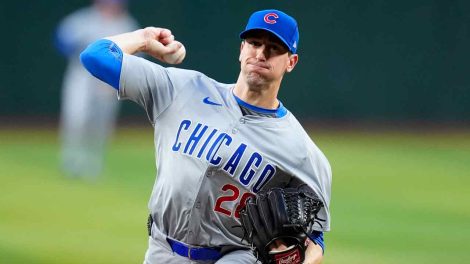TORONTO – The split with the Seattle Mariners was difficult. The two years of broadcasting with ESPN that followed were fun. A desire to return to the game never ebbed. The opportunity to reconnect with Mark Shapiro and Ross Atkins in the Toronto Blue Jays front office represented the perfect opportunity.
“Every bit of experience I’ve had, whether it’s been good, bad or ugly, is who I am today,” Eric Wedge, recently named the club’s new player development advisor, says in an interview. “I’ve been a student of the game, I’ve been a student of people, I believe in the passion and motivation it takes to be a quality human being but to be a quality baseball guy, too, and help others.
“One of the biggest reasons I wanted to get back in the game is I just missed being part of something that felt like it could potentially be special, and I felt like with Mark and Ross, as well as everybody else, it was a way to help others, be a part of something and make a difference with these players.”
Wedge’s role is the latest position created this off-season by Shapiro, the club’s president and CEO, and Atkins, the GM. At the moment he’s working closely alongside player development director Gil Kim, another job that didn’t previously exist in the front office.
A point of priority is developing the kind of organization-wide integration of philosophies and processes needed to ideally groom minor-league players for the majors.
“I believe you have to connect the big-leagues with the minor-leagues, and you do have to be all-inclusive in your organization, from scouting to player development to the big-leagues, and everything has to work hand in hand,” says Wedge. “It’s our job to create that type of environment and have that type of infrastructure.”
That’s the vision put forth by Shapiro and Atkins, one Wedge came to know while spending five seasons as a manager in the Cleveland Indians system in 2002. In 2003 he took over the big-league club and posted a 561-573 record over seven seasons that included one trip to the post-season.
From 2011-13, he was 213-273 with the Mariners and suffered a minor stroke before leaving at the end of the 2013 campaign, feeling he and the organization weren’t on the same page. Once he decided that he wanted to get back in the game, he was “looking to do it with people interested in doing it the right way, who have done it the right way before, and understand what it takes to build a consistent winner.”
While the gossip in some corners of the industry is that Wedge was brought in for a non-essential role so he could be around in case the new regime wants to change manager John Gibbons at some point, there’s little reason to think that’s the case. Barring a season of utter calamity, Gibbons is considered safe through at least the season’s end, while Wedge is fully engaged in his new duties.
He has strong beliefs on what an organization must do to build and sustain a winner, and is eager to do his part.
“It’s not just on the field, but also off the field,” says Wedge. “You want to put players in a situation and an environment that lends toward work ethic, discipline and sacrifice, so they can be not just the best player they can be, but the best person they can be, because it does go hand in hand, it does matter. I’m not talking about trying to create people that are choir boys or saints, but you want to make sure they know how to act and how to treat people and how to go about their business day in and day out. That way, you have every opportunity to be as efficient as possible in helping every player reach their potential.”
Pivotal to that, Wedge believes, is providing players with a consistent message delivered in an organized way. That starts by building them up upon entry to the minor-league system and steadily adding on to the foundation set at the beginning.
“We’re not just looking to push players through the system,” he explains. “You want to make sure they have a solid base so if they do rise to the big-leagues, they can stay there.”
Every organization, of course, aims for that, and teams that integrate young players with consistent success – think of the St. Louis Cardinals, for instance – are the ones able to sustain extended runs of success.
“It’s hard but it’s very possible as long as you’ve got the financial ability to hang on to most of your players that get to the big-leagues,” says Wedge. “The tough part with Cleveland was that you get to that point and then you have to tear it down and do it again because you can’t afford everybody. Really, you could afford very few people, that’s why we had to trade so many people off after we did build it. We were a pretty good club there. We knew how to build it, we knew how to sustain it, but you can only do that if you can hang on to at least some of your players.
“In Toronto, you’re going to be able to do that, which is fantastic. What we need to do is bridge that gap between the minor-league system and the big-league club, and make sure that we continue to develop players, players that the big-league club and the organization can count on.”
The vision is a worthy one, and the length of the Blue Jays’ current competitive window depends on how quickly it can be turned into a reality.









